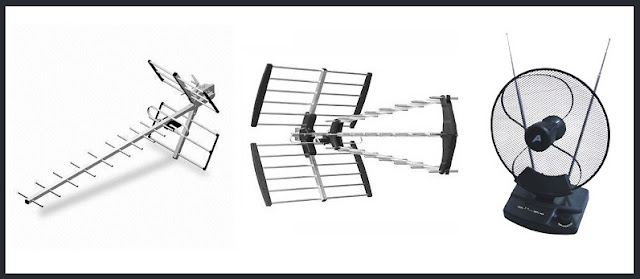If you have finally got around to a new digital
antenna installed then you are about to look forward to a new age of
television. Your digital antenna will give you access to multiple channels,
catch-up channels, interactive content and even recording and replay facilities
that will change the way you watch television forever.
Television antennas come in various types and sizes,
depending on their use and how good the signal quality is in your area.
Choosing the right antenna could be made simpler than it currently is, but if
you are in any doubt about which antenna is right for you, call in a
professional who will be able to help you with a digital antenna installation.
Yagi, Wide-band or Indoor?
The standard antenna used for many years is the Yagi
antenna, and one that you will still see on most rooftops. This type of antenna
is manufactured to be pointed at the direction of the broadcasting antenna for
your local area. Whist older television antennas that were used for analogue
television may still work fine with digital television, the cabling, routing
and quality of the reception all play an important factor.
Wide band antennas are made for picking up weak signals, and
are also used in places where multiple broadcast antennas are feeding a single
city. Or where the broadcast antennas used across a wide area interfere with
each other. This type of antenna will solve most problems associated with poor
signal and signal dropping.
If you live in an area that has good signal strength and you
are able to get strong signal quality in your home, an indoor antenna may be
all that is needed to pick up digital signals. These smaller indoor antennas
are perfect for second television sets placed around the home or for use in
sheds or outdoor buildings where no rooftop antenna is placed.
Time To Upgrade Or Replace Your Antenna?
 |
| Image Source: insightsoftware.com |
If your antenna is more than 15 or 20 years old, and you are
having trouble picking up certain channels or radio stations via your existing
antenna, an upgrade may be necessary to resolve these issues. Upgrading is easy
and usually involves a simple replacement of the antenna itself, along with
some cabling if damaged.
For the best aerial installation, you will need to use a
sturdy base to secure you antenna to, so if you have an existing base on your
rooftop, check for any damage and replace where necessary. Use high quality
copper-core coaxial cable from the antenna to your TV points in your home, and
if you have multiple outlets, ensure that you have a modern distribution box
that is placed near to the antenna and use a signal boosting system to ensure
the signal strength carries the full length of the cables.
Cable Routing and TV Point Placement
 |
| Image Source: truelocal.com.au |
Routing your coaxial is a simple process of replacing your
old cable, and upgrading where you want to install new TV points. Use cable
tacks to securely tie the cable to the outside of your property either near the
guttering of your home or near the bottom of your walls. Ensure that the cabling
is not touching the floor or the guttering itself. Route the cabling to a
window and drill a hole through the window frame for easier access and then
route to a TV point you will fix to the wall.
Ensure that with your antenna TV installation that you waterproof
the holes you drill with adequate sealant and ensure that all points of your
cabling route are waterproof, secure and trouble free.
Indoor or Outdoor Digital Antenna?
 |
| Image Source: wpexplorer.com |
Many people choose to place their aerial installation in
their loft space for easier access and to leave the roof tidy, but that only
works in strong signal areas where the signals can travel through a thick roof
with ease. For outdoor TV antenna installation follow the process above, or if
in any doubt, hire a professional digital antenna installation service.
By hiring a professional service you will have a
professional assess your needs and any planned work you wish to have done. A
cable routing plan and antenna type can be chosen before installation to
provide you with all of the knowledge beforehand along with a layout of your
cabling route, any signal boosting equipment and distribution boxes can be
bought as extras if needed, giving you a premium service for a reasonable
price.


